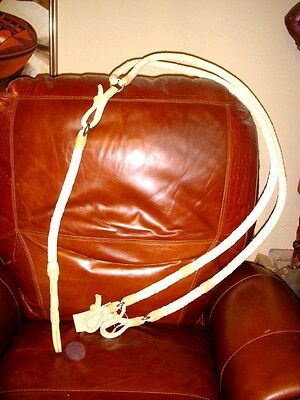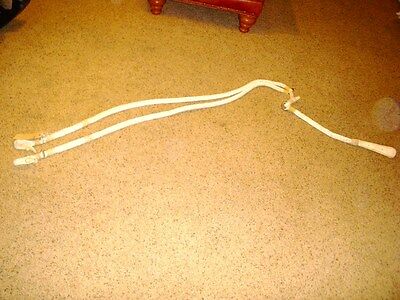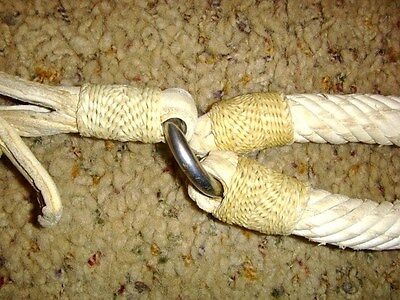-40%
CHILEAN HUASO GAUCHO CABALLO HORSE WHITE LEATHER REINS BRAIDED & TWISTED
$ 52.79
- Description
- Size Guide
Description
This is a rare offering of a new set of white reins that came from Chile. They are heavy and stiff (supposed to be) and measure about 58" inches long from the rein connectors to where the quirt attaches. The attached quirt is 23.5" inches long plus the 6" inch connector and the circumference of the reins is 3" inches around. Please check out all the pictures of this outstanding piece of horse equipment from Chile made by skilled artisans. The Huaso Gauchos (cowboys) use these reins on their caballos horses. If you need more pictures just let me know. The 2 pictures on horseback are to show the huaso attire and tack with the white reins (they look like my reins that have never been used - brand new).Bridles and Reins
"
In the
Chilean Horse
tradition headstalls, tying bosals or thin cavessons can be made from straps of rawhide but they are more commonly made of flat braided strands of leather. Browbands and throatlatches are commonly used, but not required. Once again, the tendency is to tie them into place, rather than use a buckle for this purpose.
*** The reins are always long, thick, heavy and round. When riding, typically the excess is coiled in about a four-inch loop that is held in the left hand over the withers. The reins can either be twisted or braided with a varying number of leather strands. In comparison to most reins used in other equine disciplines, the Chilean reins would be considered thick, weighty and stiff. At the union of the right and left rein, there is a small ring that serves as a point of attachment for a quirt that is made of the same material and craftsmanship as the reins. Most commonly, this has a flat leather popper on its end.
This is a rather distinguishing feature of Chilean tack, as the quirt is a fixed part of the horse’s equipment much like the Californian romal reins. This differs from the equine cultures in other areas that continue to make the quirt or crop available to the horseman once he is on the ground. Undoubtedly, this characteristic of Chilean tack has to do with the fact that the huaso rides most of the time with both hands on the reins. Others might conjecture that the huaso is rarely off his horse and does about everything on horseback. Undeniably, this custom always makes the quirt available, as it becomes a permanent fixture when riding. Oddly enough, the quirt is very rarely seen used in Chilean Rodeo competitions. As a result, forward impulse is largely determined by spur pressure and rider body weight distribution.
"
I ship with USPS Mail
insurance and tracking included and I ship as soon as cleared Paypal payment is received.



















